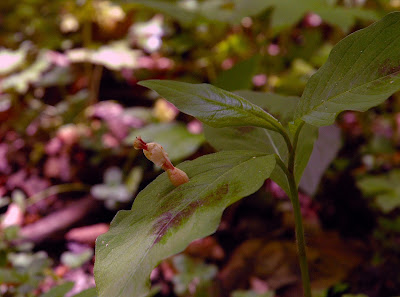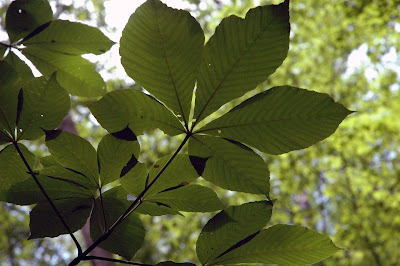Of all the local places I like to visit, Log Cabin Hollow is one of my favorites. It's just around the corner from Nelsonville, and one of the non-timber areas of Zaleski State Forest. Before I get into the uniqueness of the site, let's discuss the other part of the title, Forest Ecology. While I've touched on many of these things before, I wanted to put them all together in one rather long post.
This is an old slide I took from a fire tower of Shawnee State Forest back in the 70's. Just using it as an illustration of understanding a Formation, the largest classification after a continent. Formations like Tundra, Desert, Prairie/Grasslands are familiar to many. Formations are also referred to as Life Zones or the old term Biome. We are in the Eastern Deciduous Forest formation.
Within a formation are smaller classifications known as Associations, or what we commonly call Plant Communities. This is Log Cabin Hollow, courtesy of Google earth. In S.E. Ohio, communities are not only based on their successional stage, or how old they are, but also on what slope they occur. The red line community faces south and west, the purple line is facing north and east. Before getting to those, lets discuss the white, yellow, and the middle black lines first.
Log Cabin Hollow is not an official name, just something we use. The name derived from the fact that an old wooden cabin once stood here. It has long since deteriorated. The 'front yard' has become an Early Successional Forest dominated by these very tall tuliptrees, Liriodendron tulipfera. You would think the forest to be much older by the size of the trees, but tulip is a fast growing species. A few sycamores, hickories, and sugar maples also dot the setting. The dominant understory tree is Musclewood, Carpinus caroliniana.
As I arrived, I was greeted by Spicebush Swallowtails and this Tiger Swallowtail actively puddling for minerals.
The soils are moist to wet here in the bottomland. Pennywort is a common species here.
Greek Valerian and Wild Ginger are also abundant.
Sweet Cicely, Aniseroot, Dwarf Crested Iris, Wild Blue Phlox, Blue-stemmed Goldenrod, Clustered Snakeroot, Cleavers, Long-spurred Violet, and Purple Cress are just a few of the many species found here. Because I'll be mentioning SO many plants and animals, I will skip many of the latin names to save time and space.
The yellow line on the map is actually private property bordering the area. While it doesn't look exactly like this today, it is an example of an 'old field' successional stage. The site had a mobile home and a mowed yard. Once that is abandoned, you can see changes take place. Sumacs, crabapple, hawthorn, and blackberries move in. Pioneer species as we call them. Examine this spot for open field summer flowers, and it's the only place here you can find Yellow Warblers and Common Yellowthroats.
As we move back into the woods, Ebony Jewelwing Damselflies can be seen along the stream. Also found here are members of the rare dragonfly family known as Spiketails.
The black line on the overview follows the ravine community. This steep banked hollow is lined with River Birch, Sycamore, Beech, and Yellow Buckeye.
The stream is clean, cold, and with a high dissolved oxygen content. Mayfly, Stonefly, and Caddisfly species abound.
Red-backed, Two-lined, and Dusky Salamanders are common. The rare Spring Salamander, Gyrinophilus porphyriticus has also been found here.
Moss covered rock outcrops are often full of Christmas Fern, Bishop's Cap, Wild Stonecrop, and Stinging Nettle.
Jewelweed, False Solomon's Seal, Jack-in-the-Pulpit, and Maidenhair Fern are typical of these shady moist ravines. The big leaves behind the Jack are Large-leaved Waterleaf, Hydrophyllummacrophyllum, a very hairy species when in bloom.
Not often seen is another treat on the rocks, the Walking Fern, Asplenium rhizophyllum.
Besides ferns and moss, many rock faces are entirely covered with Liverworts.
As you approach the back half of the hollow, the sides become steeper. The going gets rough as the bottom is full of large boulders and many fallen trees blocking the way. This is the habitat of the Louisiana Waterthrush.
Vegetation changes at this point also. Yellow Birch, Betula alleghaniensis, is another uncommon plant in the area. Many of the larger trees have now fallen, but the saplings now dominate the understory.
Besides Yellow Birch, Witch-hazel and Wild Hydrangea are the other understory dominants.
The end of the Hollow has a nice waterfall, and the rocks are covered with Partridgeberry, Mitchella repens.
Time to head up the slopes. We'll start with the North-east facing side. This slope is cooler and moister. The soil is rich, has a higher pH, and the diversity of plants is greater here than any other spot.
Wild Geranium is just one of the many typical flowers you expect on these slopes. Large-flowered Trillium, Drooping Trillium, Spring Beauty, Hepatica, Rue Anemone, Bloodroot, Bellwort, Baneberry, and Blue Cohosh are all here. Those long narrow structures are the fruit of Wild Geranium.
Bladdernut, Staphylea trifolia.
The white lines on the twig of Wahoo, Euonymus atropurpurea.
Pawpaw, Asimina triloba.
Spicebush, Lindera benzoin.
Blackhaw, Viburnum prunifolium. These are some examples of the understory species that are found here. I wish to concentrate on the diversity of tree species instead. Most plant communities are named for the 2-3 dominant species found. Examples include Elm-Ash forests, Beech-Maple, Oak-Hickory, etc. There are many more than just a couple dominants in this canopy, let's look at the make up.
Green Ash, White Ash
Bitternut, Mockernut, Pignut, and Shagbark Hickory.
Wild Black Cherry
Red Elm, American Elm
Black Maple, Sugar Maple, Red Maple.
Red Oak, White Oak, American Beech.
Like a torpedo shot from a sub, this fallen Buckeye flower appears to have embedded itself on this smartweed leaf.
Yellow Buckeye, Aesculus flava, is an important component of these forest types.
A second important species is once again, the Tuliptree.
A third indicator species is American Basswood, Tilia americana.
Multiple species in a canopy, especially with Basswood, Tulip, and Yellow Buckeye, tells us we have a Mixed Mesophytic or Appalachian Cove forest. Environmental conditions are just right for all these species to thrive. In some areas, given enough time, Beech and Sugar Maple will end up the most dominant because of their shade tolerance.
Animals found here include the Skunk, Raccoon, Opossum, White-tailed Deer, Box Turtle, Grey Squirrel, Flying Squirrel.
And what of the birds? Turkey and Ruffed Grouse will prowl these grounds. In the upper canopy look for Scarlet Tanagers, Red-Eyed and Blue-headed Vireos, and Eastern Wood Peewees. The understory is rich with Acadian Flycatchers, Wood Thrush, Cuckoos, Hooded, Kentucky, and Ovenbird Warblers.
Here is the hollow in the autumn. Notice the black arrow shows the changing of fall colors. These are the multiple tree species I just discussed. The orange arrows show large patches of trees still bright green. These are mostly Oaks. They keep their leaves on much longer. Those are the West and South facing slopes.
These slopes are drier because they are exposed to the sun during the hottest time of day. The soils are rocky, poor, and usually acidic. More tolerant species of Moss and Lichens cover the ground and rock outcrops.
Just a snowballs throw away from the other side, these are Mixed Oak forests. White, Red, Black, Chestnut, Scarlet, and Post Oak. The understory is dominated by Sawbrier, Smilax rotundifolia.
Low Blueberry, Deerberry, and Huckleberry are other occasional shrub species. Blackgum, Black Locust, and Sourwood can also be found.
When you combine the measurements from plot data, (density, dominance, and frequency), the most abundant plant of the understory here is Sassafras. As a pioneer species how can that happen? Sassafras comes in between the oaks from breaks in the canopy. None of them are more than ten feet tall, and none will tend to survive because they are too shade intolerant.
We'll quickly run through some of the more upland oriented plants found on these slopes. This is 3-lobed Violet.
Violet Wood Sorrel
Rough-fruited Cinquefoil
Yellow Star-grass
Pussytoes, both Field and Plantain-leaved.
Rattlesnake-weed
Dwarf Larkspur
Indian Tobacco
What better way to end than with Fire Pink. Very few of the plants will be found on both slopes. Most of the same animals will occur on either hillside. Many upland dry forests will include Blue Jays busy gathering acorns, Fence Lizards, and Copperheads! That was a long way to go, but I hope you can see how plant communities can vary so much depending upon their habitat.








































